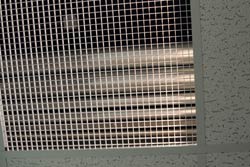Don't Forget to Look Up!
 When evaluating the cleanliness of the computer room, it is important to think outside of the box—literally! In many rooms, there is air space below the raised access floor and above the suspended ceiling. Inspection and cleaning below the access floor is now standard practice, but what lies above?
When evaluating the cleanliness of the computer room, it is important to think outside of the box—literally! In many rooms, there is air space below the raised access floor and above the suspended ceiling. Inspection and cleaning below the access floor is now standard practice, but what lies above?
In rooms with a false ceiling, there is an important area above the ceiling tiles. It is a void that allows access to mechanicals, conceals structural elements and, in some cases, acts as a pathway for airflow. It is also an often overlooked space when it comes to cleaning.
The distance from the suspended ceiling to roof deck can vary from a few inches up to 20 feet or more. This large enclosed space can be a significant source of contamination in your computer room. Dust, fireproofing, fiberglass fibers and even construction debris will settle on the ceiling tiles and other flat surfaces in the ceiling. When the ceiling serves as an active air plenum (most commonly as a hot-air return), the danger is obvious: contaminates will be carried by the moving air and circulate throughout the room.
Even without active airflow above the ceiling, material can be released into the computer room area. When panels are opened by the staff for maintenance and repairs, a large amount of dust and debris can fall onto the IT equipment below. Less dramatic, but more pernicious is the contamination that occurs while the ceiling tiles remain in place.
The air pressure in a computer room is continually changing: CRAC units cycling, floor tiles being opened, room doors closing, etc. These changes in pressure disturb the ceiling tiles causing them to lift and settle. This motion causes dust and debris to fall from the ceiling grid into the room below. The ceiling is anything but a sealed space!
 Regular cleaning of the above ceiling area is critical. Of course, in the data center this is a delicate task. Access involves negotiating the IT equipment throughout the room below and detailed cleaning requires careful control of the contamination above. Fortunately, Data Clean technicians have the proper tools, techniques and training to manage this critical task.
Regular cleaning of the above ceiling area is critical. Of course, in the data center this is a delicate task. Access involves negotiating the IT equipment throughout the room below and detailed cleaning requires careful control of the contamination above. Fortunately, Data Clean technicians have the proper tools, techniques and training to manage this critical task.
For more information and a full evaluation of your environment, contact your local Data Clean account manager for more information.

